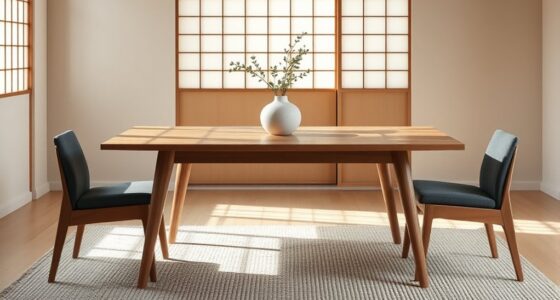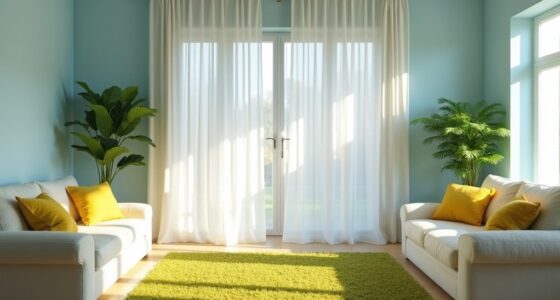When choosing between warm and cool whites, think about the mood you want and the space’s function. Warm whites create cozy, inviting areas perfect for living rooms and bedrooms, while cool whites make spaces look fresh, modern, and brighter, ideal for kitchens and offices. Consider your lighting and existing decor, as undertones can influence the overall feel. Stay with us to discover tips on testing and combining these shades for a balanced look.
Key Takeaways
- Warm whites with yellow undertones create cozy, inviting spaces, while cool whites with blue undertones offer a crisp, modern look.
- Consider room function; warm whites suit living areas and bedrooms, cool whites are ideal for kitchens and offices.
- Test paint samples in different lighting conditions to observe color shifts and ensure harmony before finalizing.
- Balance warm and cool whites to enhance contrast, mood, and overall aesthetic, especially in multi-purpose or open-plan rooms.
- Match white undertones with existing décor and furniture for a cohesive, harmonious design.
Understanding the Temperature of White Paints
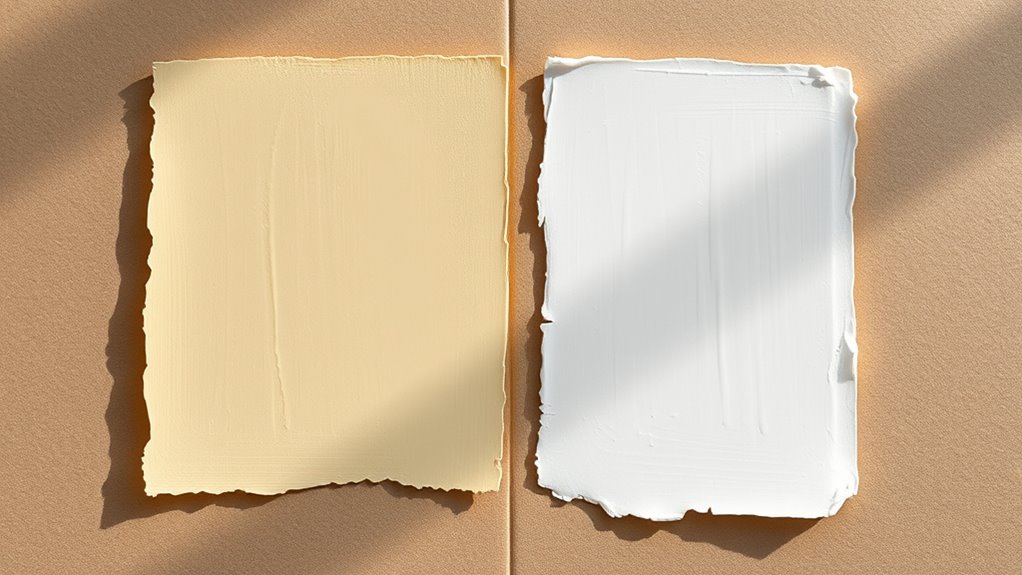
White paints vary in their temperature tone, which can considerably affect the mood and feel of a space. Understanding this helps you choose the right white for your room. Warm whites tend to have yellow or beige undertones, creating a cozy and inviting atmosphere, while cool whites have blue or gray undertones, offering a crisp, modern look. Your choice impacts color psychology, influencing how you feel in the space. Additionally, consider paint durability—some whites maintain their hue longer and resist discoloration better than others. Knowing the temperature of a white paint helps you achieve the desired ambiance and ensures longevity. color psychology also plays a role in how a space feels, guiding your selection to match your intended mood. By selecting the right tone, you set the perfect foundation for your interior design, making your space both visually appealing and emotionally satisfying.
Visual Impact of Warm Whites in Interior Spaces
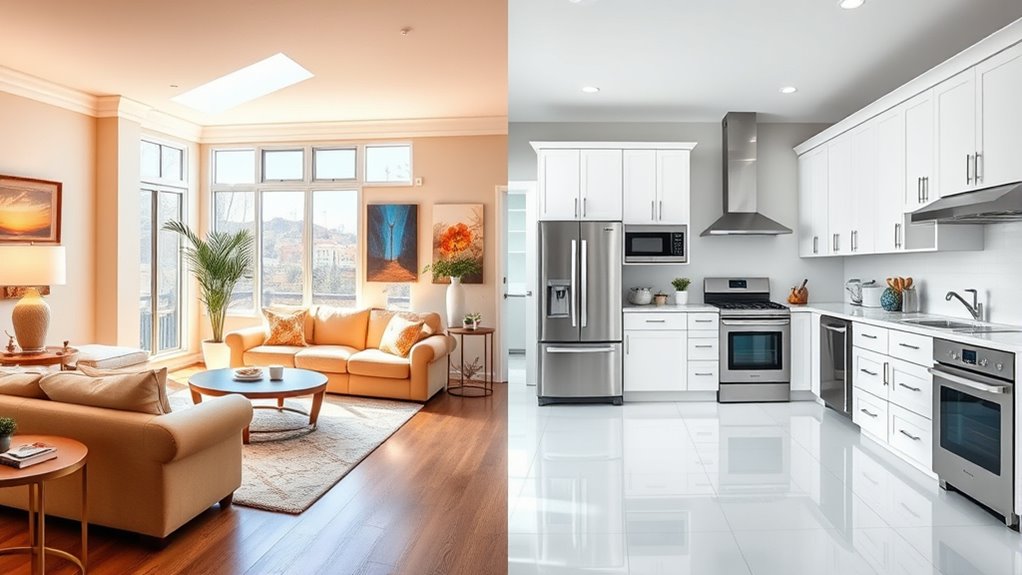
Warm whites create a cozy atmosphere that makes your space feel inviting and comfortable. They also enhance natural light, making rooms appear brighter and more open. By choosing the right warm white, you can substantially impact the overall mood of your interior. Incorporating attention in creative practice can help you select and utilize warm whites more effectively, ensuring your space reflects the desired ambiance.
Creates Cozy Atmosphere
When you choose warm whites for your interior, you instantly create a cozy and inviting atmosphere. The color psychology behind warm whites promotes feelings of comfort and relaxation, making your space feel more intimate. These shades naturally evoke a sense of warmth, encouraging social interaction and calmness. By selecting warm whites, you enhance the mood of your environment, making it perfect for unwinding after a long day. Their soft, gentle tones help diminish harshness, fostering a welcoming vibe. Whether in a living room or bedroom, warm whites draw people in and create a sense of safety. This mood enhancement transforms your space into a sanctuary where you feel at ease, making your home feel even more personal and inviting. Incorporating lighting choices that complement warm whites can further amplify their cozy effect.
Enhances Natural Light
Because warm whites have subtle undertones that reflect natural light effectively, they can make your interior spaces appear brighter and more open. This enhances lighting effects, creating a soft, inviting glow that boosts the overall ambiance. By amplifying natural light, warm whites reduce the need for artificial lighting during the day, making rooms feel more spacious. The psychological impact is also significant; spaces feel warmer, more welcoming, and comfortable. These shades subtly influence your mood and perception, fostering a sense of calm and relaxation. When choosing warm whites, you’ll notice how they interact with sunlight, helping your interiors look vibrant without overwhelming the senses. Additionally, color undertones play a crucial role in how well the white reflects natural light and complements other decor elements. Overall, warm whites maximize natural light, elevating your space’s visual impact and emotional appeal.
How Cool Whites Influence Room Atmosphere
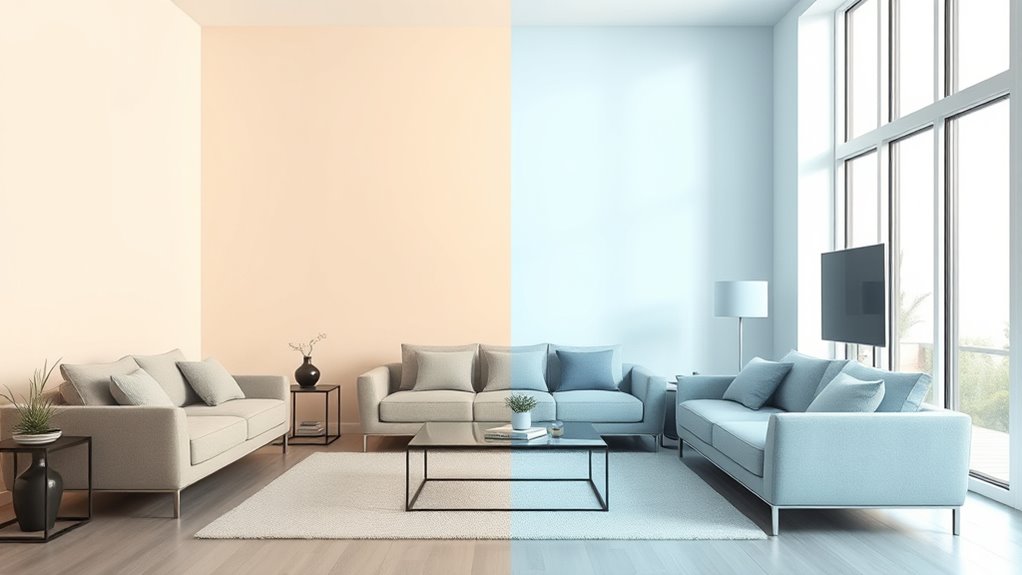
Cool whites, with their subtle bluish or gray undertones, create a crisp and invigorating atmosphere in a room. They influence how you perceive space and can boost alertness through their color psychology. When paired with lighting effects, cool whites enhance the sense of openness and cleanliness. They work well in spaces designed for focus or productivity, like offices or kitchens. Keep in mind:
- They evoke a modern, sleek vibe
- They can make a room feel larger and more spacious
- They highlight architectural details effectively
- They may feel colder or less cozy if overused
- They emphasize a clean, minimalist aesthetic
- Incorporating natural materials can soften the starkness of cool whites and add warmth
Choosing cool whites impacts your room’s energy and mood, making it feel fresh, vibrant, and energizing.
Comparing Undertones: Yellow, Pink, and Blue Hues
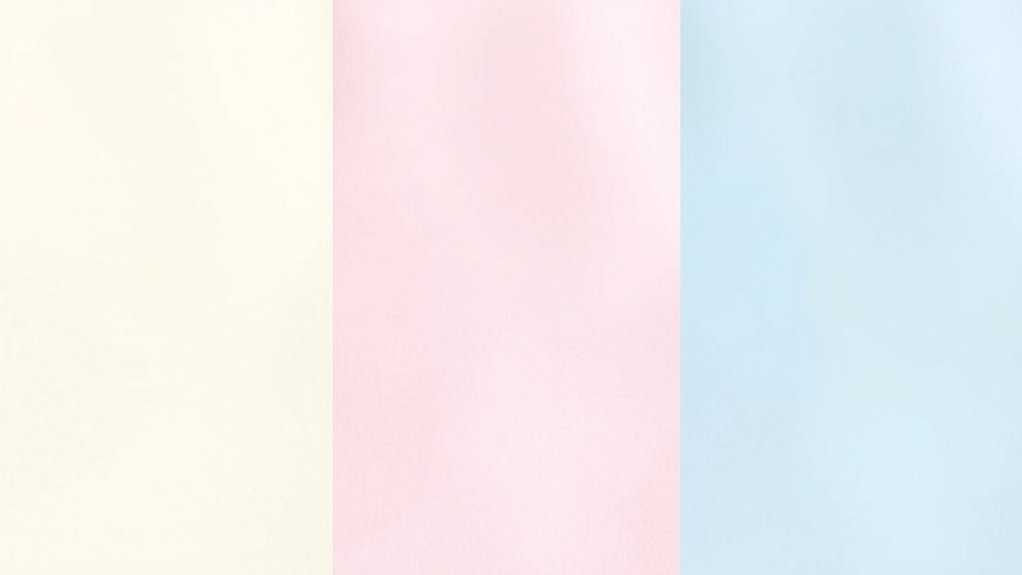
Undertones play a crucial role in how white paint influences your space, and choosing between yellow, pink, or blue undertones can drastically change the room’s mood. Yellow undertone variations create warmth and energy, making a space feel inviting and lively. Pink undertones add softness and subtle elegance, perfect for creating a gentle, calming atmosphere. Blue undertones bring a cool, serene vibe, fostering tranquility and freshness. When comparing these undertones, consider how they interact with existing colors and lighting to achieve color harmony. Small shifts in undertone can make a significant difference in the overall feel of your room. Understanding these undertone variations can help you select the right white that best complements your style and enhances your space’s ambiance.
Choosing the Right White for Different Room Types

Choosing the right white paint depends heavily on the specific room you’re decorating. Different spaces benefit from whites that enhance their purpose and style. For a living room, opt for warm whites that create a cozy atmosphere and complement your furniture pairing. In a kitchen, crisp cool whites can make the space feel fresh and clean, ideal for color coordination with appliances and cabinetry. Bedrooms often work well with soft, muted whites that promote relaxation. Bathrooms benefit from bright whites that reflect light and add a sense of cleanliness. Consider these tips:
- Match whites with existing furniture tones
- Use warm whites for cozy, inviting spaces
- Choose cool whites for modern, sleek looks
- Balance light and dark shades for contrast
- Test how whites look in natural vs. artificial light
- Incorporating interior design basics can help you achieve a harmonious color scheme.
This approach guarantees your room feels cohesive and inviting.
Tips for Testing Whites Before Committing

Always test whites in different lighting conditions to see how they shift throughout the day. Use sample boards to compare how various whites look side by side in your space. This way, you’ll guarantee the shade you pick truly works with your lighting and decor. Incorporating an understanding of cloud formations and natural weather indicators can also help you anticipate how ambient light may change over time, ensuring your choice remains consistent across different conditions.
Test in Different Lights
Since lighting can dramatically change how white paint looks, it’s essential to test your chosen shade under different conditions before making a final decision. Natural light, artificial bulbs, and shaded areas can all influence how the color appears, affecting your perception of warmth or coolness. Testing in varied lighting helps you understand the true tone and how it complements your space’s overall vibe and color psychology. Also, consider how different lights impact paint durability, as some whites may show imperfections more readily. To get an accurate feel, try these tips:
- Observe your walls during different times of day
- Use sample patches in well-lit and dim areas
- Check under warm versus cool bulbs
- Look at your paint in shaded versus sunny spots
- Trust your instincts on how it makes you feel
- Remember that paint spoilage can sometimes influence color appearance if not stored properly.
Use Sample Boards
Using sample boards is one of the most effective ways to see how white paint will truly look in your space before making a final commitment. By applying different whites to sample boards, you can evaluate how each shade interacts with your existing decor, lighting, and color scheme. This hands-on approach helps you understand how paint formulation influences the final appearance, especially under various lighting conditions. Incorporate principles of color theory to predict how warm or cool tones might shift throughout the day. Testing samples side by side allows you to compare subtle differences and avoid surprises. Ultimately, sample boards give you a clearer, more confident decision-making process, ensuring the white you choose complements your space perfectly. Considering shade temperature can further refine your choice by aligning with your desired ambiance and lighting environment.
Combining Warm and Cool Whites for Balanced Design
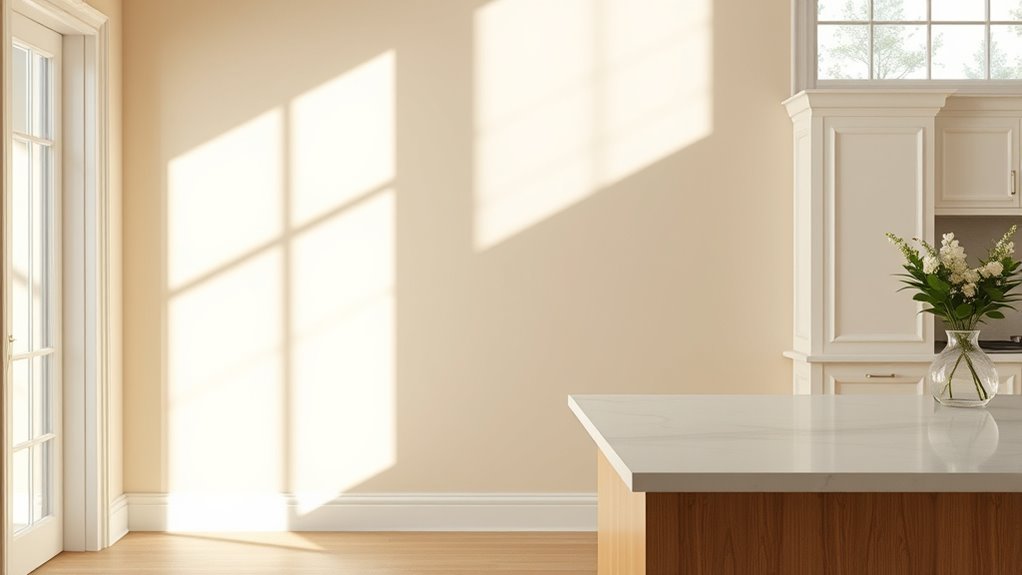
Blending warm and cool whites can create a balanced and inviting space, but it requires thoughtful pairing. To achieve effective color mixing and maintain design harmony, consider these tips:
Blending warm and cool whites creates inviting, harmonious spaces with careful pairing and balance.
- Use warm whites for areas you want to feel cozy and inviting.
- Incorporate cool whites to add freshness and brightness.
- Introduce subtle accents of one white tone within the other for seamless shift.
- Keep a consistent undertone to prevent clashing.
- Balance the proportions of warm and cool whites based on room function and lighting.
Frequently Asked Questions
How Does Lighting Affect the Appearance of Warm and Cool Whites?
Lighting effects profoundly influence how you perceive white shades. When you change the lighting, it alters color perception, making warm whites appear softer and cozier under yellow-toned lights, while cool whites seem crisper and more clinical under bluish lighting. Your choice of lighting can enhance or diminish these effects, so consider the environment and mood you want to create when selecting lighting to showcase the specific white tone.
Can Choosing the Wrong White Color Affect Room Resale Value?
Choosing the wrong white paint can be a gamble that impacts your home’s resale value, like casting a shadow over potential buyers. If you pick a color that clashes with your decor or looks dull over time, it may seem like poor white paint durability or flawed paint application techniques. To avoid this, select a versatile white that enhances space and guarantees a fresh look, appealing to future buyers.
Are There Skin Tones That Clash With Specific White Shades?
You might notice that some white shades clash with certain skin tones. Skin tone compatibility is key to preventing color clash, ensuring your space feels harmonious. If you have warm undertones, opt for whites with creamy or buttery hues to complement your skin. Cooler undertones work better with stark whites or those with bluish undertones. Matching whites to skin tones helps prevent color clash and creates a balanced, inviting atmosphere.
How Do Maintenance and Cleaning Differ for Warm Versus Cool Whites?
Imagine your white paint as a pristine snowfield—clean and bright, yet vulnerable to surface stains. Cleaning techniques differ slightly: warm whites, with their creamy undertones, may hide surface stains better but require gentle scrubbing to avoid discoloration. Cool whites, like icy glaciers, demand prompt attention to surface stains to maintain their crispness. Regular dusting and spot cleaning keep both whites shining, but adjust your approach based on their subtle undertones.
What Are Common Mistakes When Mixing Different White Tones?
When mixing different white tones, you often make the mistake of ignoring white pairing harmony, leading to a tone mismatch. You might combine whites with subtle differences, creating an uneven or patchy appearance. To avoid this, compare the undertones first, and choose whites that complement each other. Testing a small area before committing helps guarantee your whites blend seamlessly, preventing jarring contrasts and achieving a cohesive look.
Conclusion
Choosing the right white paint can transform your space, creating the perfect mood and vibe. Did you know that rooms painted with warm whites can feel up to 20% cozier? By understanding undertones and testing samples first, you’ll guarantee your choice complements your style. Whether you prefer warm or cool whites, blending them thoughtfully brings harmony and balance. Trust your instincts, experiment, and watch your space come alive with the right white for you.



